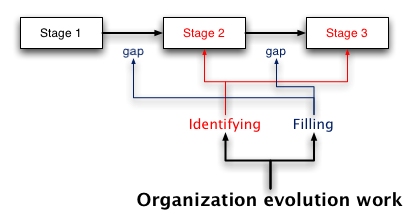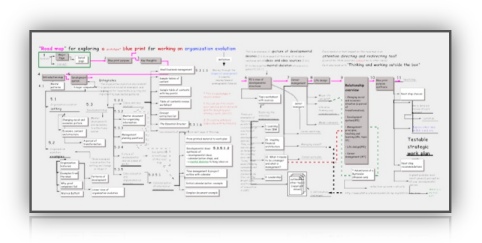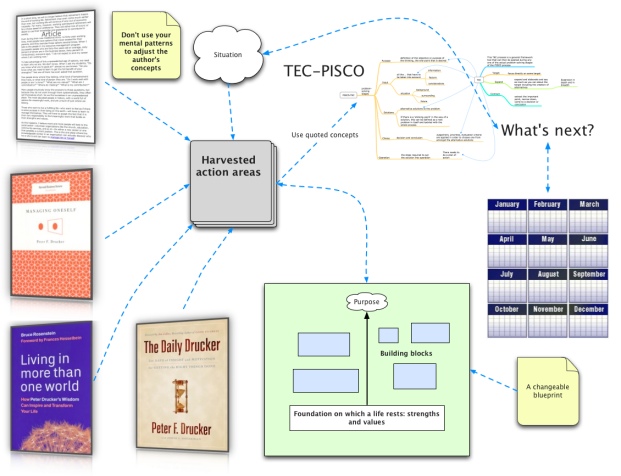Organization Evolution © ℠
A prototype blueprint for
WORKING on organization evolution © ℠ [ definition ]
in a world relentlessly moving
toward unexpected and unimagined futures
This is a part of CEO work area landscapes which need major revisions

This page:
 What is organization evolution? What is organization evolution?
 What are the benefits of organization evolution? What are the benefits of organization evolution?
 What are the benefits of having an organization evolution work approach blueprint? What are the benefits of having an organization evolution work approach blueprint?
 What is the central fundamental challenge? What is the central fundamental challenge?
 What are some of the key elements of the blueprint? What are some of the key elements of the blueprint?
What is organization evolution?
My quick definition: Movement through the life STAGES of a healthy and successful organization. To be useful this concept must contain all possible future concepts.
Here is a longer definition

At what point does this stage identification and gap filling end? Never
The best time to work on organization evolution is when you are successful. When the need becomes obvious there is little choice, but then you are the least financially capable of coping with the situation.
The question of how to tackle this conceptually challenging work is introduced below.
What are the benefits of organization evolution?
From society's standpoint, organization evolution is the CORE of WEALTH CREATION and PRESERVATION plus economic and social development.
Organization evolution explains how we got from the world of 1900, 1950, 1980 to today's world and how we'll get to tomorrow's worlds. It is only through wealth (what's left over after consumption) that we are able to fund this development.
From the individual's standpoint, organization evolution explains the existence of good jobs and personal wealth.
What are the benefits of having an organization evolution work approach blueprint?
A blueprint provides a specific view. It provides something you can modify to define your informed, developmental desires.
EXPLORING THE BLUE PRINT has several benefits
-
leads to some valuable ideas for visualizing the strategic picture (by itself this is a valuable communication tool—it can help a group visualize and discuss)
-
provides a view of long-term organization evolution work
-
provides a tentative organization evolution interest profile that acts as an early action alert
-
presents a prototype for creating one's own customized approach or comparing to your current efforts
-
access to my 30+ years of full time exploratory work
What is the central fundamental challenge?
Imagine we were discussing "this" in 1850.
What would anybody have known about the years that were to follow?
And yet almost everyone is confident that tomorrowS will just be an extension of today.
Try to recall the different conditions that existed almost decade by decade between then (1850) and now.
Why would today and the tomorrowS that follow be any different?
So the central fundamental idea is that we need a systematic way of creating world class management mental patterns that drive organization evolution work.
This systematic way must take into account the changing body of human knowledges.
What we do is limited by our awareness (what we've paid attention to) and what we understand.
Our actual outcomes are influenced by what others see, understand, act on and the strategies they employ.
In many competitive arenas there are only one or two resource healthy competitors.
So the fundamental idea is that we need a work plan that is adequate to the challenges we face and takes us where we want to go.
The blueprint helps create this work plan
What are some of the key elements of the blueprint?
 The most fundamental ideas is to create a organization evolution work map. The image below is a 2001 version work map that I have since abandoned for a free-form erector set model. The work map is created by exploring conceptual resources and arranging the pieces. The most fundamental ideas is to create a organization evolution work map. The image below is a 2001 version work map that I have since abandoned for a free-form erector set model. The work map is created by exploring conceptual resources and arranging the pieces.


Career and Life Guidance from Peter Drucker
is attention-directing work
 Organization evolution related articles acquired from a wide variety of news sources. Also I have a subset of these in my delicious bookmarks Organization evolution related articles acquired from a wide variety of news sources. Also I have a subset of these in my delicious bookmarks
 Organization histories that illustrate the idea of stages. Wikipedia has histories for many organizations. Organization histories that illustrate the idea of stages. Wikipedia has histories for many organizations.
 Tables of contents and "quotations" from more than 100 major books. These resources are aids to discovering and evaluating potential time investments. We can only work on concepts or ideas on our radar—attention switching comes first. The human brain can only see what it is prepared to see—mental patterns. Tables of contents and "quotations" from more than 100 major books. These resources are aids to discovering and evaluating potential time investments. We can only work on concepts or ideas on our radar—attention switching comes first. The human brain can only see what it is prepared to see—mental patterns.
-
Leadership (what needs doing?)
-
People decisions (determine the performance capacity of the organization)
-
Entrepreneurship and Innovation (article and book outline)
-
Startup planning
-
Managing the small business (contrast the key radar elements with those on Chief TLN Officer page)
-
The Winning Performance (midsize growth companies)
-
Good to Great and Good to Great and the Social Sectors by Jim Collins
-
Built to Last by Jim Collins
-
Toward new organizations
Increasingly, companies, even quite small ones, have to be run as “transnational” businesses. Their market may still be local or regional, but their competition is global. Their strategy also has to be global, in respect to technology and finance, products and markets, information and people. This is also true for organizations other than businesses.
-
Who Says Elephants Can't Dance by Louis V. Gerstner, Jr.
-
The Definitive Drucker by Elizabeth Haas Edersheim
-
Management, Revised Edition by Peter Drucker with Joseph A. Maciariello
-
Management: What is a business? (This applies to all sectors of society not just business) What contribution? Higher concept than best in class. Quality is what the customer gets out of it rather than what the producer puts in.
-
People decisions (and building on their strengths) > Effective decisions: What is our business, what will it be, what shoud it be? > Marketing and Innovation objectives > Priority areas within each area > Key activities > Budgets (operating and opportunity) > Key controls and measurements related to marketing and innovation objectives. Knowledge worker productivity and treating them as volunteers.
-
Being a change agent
-
Organized abandonment of things that have been shown to be unsuccessful (If we weren't doing this today, would we go into it now?) (Been there, done that)
-
The organized and continuous improvement of every product, service, and process within the enterprise (which the Japanese call kaizen)
-
The exploitation of successes, especially unexpected and unplanned-for ones
-
Systematic innovation
-
Toyota Production System (Beyond Large-Scale Production)
-
Chaotics by Philip Kotler and John A. Caslione
-
Reality Check by Guy Kawasaki
-
Books on thinking by Edward de Bono
-
PIMS outline and PIMS pdf
-
Warren Buffett's views
-
About conceptual resources
 Conceptual resource digestion process — a slimmed down view of concepts to daily action Conceptual resource digestion process — a slimmed down view of concepts to daily action
 A foundational view of economic content and structure A foundational view of economic content and structure
In addition this sites has an extensive collection of career and employee development resources : early career work, managing oneself and the second half of your life are good starting points.

Organization evolution © ℠ :: Concept Introduction
Organization evolution concept map
Linear view of organization evolution
Patterns of development
Evolving organization structures
Copyright © 2001 - 2017 Bob Embry. All rights reserved.
TLN Keywords: tlnkworganizationevolution
|
![]()
